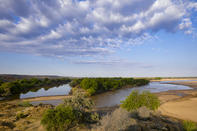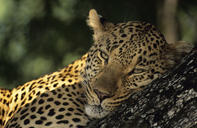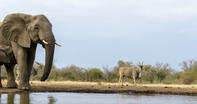Big Riverine Trees

Next morning we woke early to a babbler-francolin-and-goose cacophony. Big riverine trees stood over their perfect reflections. A thin mist waited for the heat to dissolve it. We coursed east through Tumelo, a reserve which fitted neatly into the triangle where three nations came together. The northern bank was dotted with sporadic stands of ‘mashatu’ or nyalaberry (Xanthocercis zambesiaca), sycamore fig (Ficus sycomorus) and jackalberry (Diospyros mespiliformis) which had escaped the ravages of the Tuli herds.
A rocky island surrounded by a sandy Shashe and Limpopo confluence formed the meeting point of the countries. We parked on a koppie. Zimbabwean donkeys ambled towards us, fat Botswana crocodiles watched their progress, salivating. A Bushbuck, South African Airforce spotter plane, swooped between the trees looking for ‘illegal aliens’ trying to cross into the republic.
After the mishap of losing Klaas and our close encounter with a big herd of elies, we ducked back into South Africa via Pont Drift border post. Then eastward through the Limpopo Valley Conservancy where endless mopane woodland in yellowing livery stretched to red-bouldered koppies. Fat baobabs stood head and shoulders above the mopane, like the bushveld was sprouting many-limbed ideas. “They look like they need to go on Weight Watchers,” said Sannie.
It took much of the day to reach Makuya Park on the Kruger’s northwestern border. Mutale Falls is a spectacular tented camp on the brink of a cliff overlooking the river of the same name. Fish-eagle sentries studded the trees. The sun descended over an Africa unscarred by human intervention. Trees cracked like rifle shots marking the path of elephants moving along the opposite bank. We sat on the wooden deck watching the sky darken to a rind of orange. The river became a thread of silver in the gloaming; lanterns lit a sandy path to our cliff-top tents.
Big Five Spotting

The next day’s drive was south on gravel tracks through Shangaan villages bordering the Kruger. Rondavels were decorated in geometric paintwork; some clung to hillsides in clusters of four, others on stone terraces. Pawpaw trees, fields of corn, muddy roads to test our driving.
We stopped at the Ivory Trail’s Baleni Camp at a place called Sautini (the place of salt). Klaas explained how this had for ages been an important salt mining area for the Shangaans.
He showed us conical blocks of salt, recently ‘mined’ at a nearby spring. Like ivory, salt had been a trade commodity which made its way to the Reef or the coast. Baleni’s kraal was neatly swept, colourful rondavels stood beneath established trees and a woman cooked pap at the campfire . . . but we had to press on.
On good roads Klaas was a slowcoach, but when we went offroad (like now) he was transformed, bounding over rough terrain like a spring hare. Sannie took to calling him ‘Klaas the haas’. “We’re the foxes chasing the hare!” she shouted with glee as Klaas disappeared down another bush track.
We overnighted at Mtomeni Camp in Letaba Ranch. It’s set on a lovely bend of the Letaba River (which destroyed the camp in the floods of 2000) and each tent overlooks the water. A crested barbet was replaced, with the setting sun, by a nightjar which flitted in and out of the shadows as our boerewors sizzled on the fire.
From Phalaborwa into the Kruger for our ‘Big Five day’ . . . or at least our best shot at it. Sannie, I noticed with pleasure, seemed to be into the overlanding groove now and had stopped calling herself a city kid. Her eyes had learnt to penetrate the bush expertly, looking for game. She was already spotting more than me.
The day started inauspiciously with a group of sulky marabou storks snapping at each other with clapping bills; others sat moodily hunched in their overcoats. But then things got sharply better and we managed all Five in the space of two hours: a small elephant herd up close, lions mating beside the vehicle, a 100-strong herd of buffalos, an iconic rhino standing in the road . . . and a leopard up a tree devouring an impala.
Ancient Tales of Ivory

Apart from the game excitement we also stopped at Letaba Camp Elephant Hall Museum to learn about pachyderm history, physiognomy and lore. Photographs (and tusks) of the great grey indunas of the park adorned the walls, many of them having succumbed to modern-day ‘hunters’ with AK47s.
That night the Ndzhaka Camp in Manyeleti Game Reserve provided a haven after the excitement of the day. Or was it illusory. Five lions had recently made a kill in camp; a leopard coughed somewhere in the tree line. Cats were old hat now and Sannie hardly needed a guide to accompany her to the tent along raised walkways.
Nearing the end of our trail, we ascended the Mpumalanga Escarpment via Klaserie and the Lekgalameetse Nature Reserve where dripping forests and waterfalls provided relief from days of dry bushveld. We paused at Kerkenbos, an enchanting glade of yellowwood trees where once the farmers used to hold church services, and at the grave of the district’s most famous pioneer farmer, Orrie Baragwanath.
Our 4x4s traversed a winding, mountain track built by Italian prisoners of war during the Second World War, crawling over rocks and boulders at tortoise pace. Bumping, bouncing, grinding upwards in first gear, four low. It took most of the day to reach Mafefe Camp, a ring of rondavels surrounded by a low mud wall on a precipitous plateau. Foul weather had set in and clouds swirled about the peaks.
I quickly made a fire and we huddled closer. The wind was shrill in the trees overhead as Klaas lit his pipe. “Ja, the last elephant . . .” he said, then paused for a long time. “Bvekenya’s last elephant was called Dhlulamithi. A legendary tusker. Bvekenya’s first shot didn’t bring him down and now the chase was on. The hunter and his helper tracked him for many days.
“Just when Bvekenya was about to give up, he spotted Dhlulamithi standing in the shade of a tamboti tree. He lifted his rifle and through the sights saw the elephant’s eyes, his weary face, the scars of many battles on his skin. But he also saw the strength and wisdom. Bvekenya lowered his gun. ‘I have killed enough,’ he said. It was November 1929.”
We stared into the coals. The next morning we’d take a mountain pass to the mining village of Penge where our tracks would part. But just then the ancient tales of ivory crowded round the fire like ghosts. No one said a word.
By Justin Fox